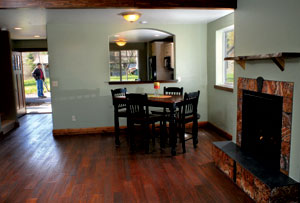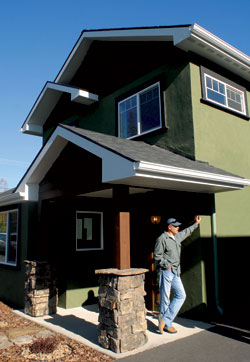WHITEFISH – Jon Lystne got tired of massive landfill runs, where he would throw heaps of construction debris onto even larger piles of other waste.
There had to be a better – perhaps “greener” – way, he thought.
So with that, he went green. Today his first eco-friendly project, a townhouse duplex in Whitefish, is finished and on the real estate market. He also has a combination subdivision – some green, some traditional building – in the works, with construction beginning as early as next year.
And while his $360,000 townhouses don’t fall into the category of affordable housing, they’re certainly cheaper than most of the custom green houses being built in the area, which usually run at least $1 million.
“I think that these homes are built on the human scale,” Lystne said.
 |
|
The open floor plan of John Lystney’s “green” townhouse features a temperature sensitive boiler, radiant heat and an air exchange system. |
Lystne estimates he’s the only builder in the Flathead Valley constructing green spec houses, as opposed to custom residences. Dave Gawe, a Realtor with Windermere in Whitefish who represents Lystne agrees with that assessment, reiterating the relative affordability of the houses.
“That’s why I call him a pioneer,” Gawe said. “He kind of stuck his neck out there.”
According to the U.S. Green Building Council, buildings, both residential and commercial, account for 40 percent of all raw materials used in the United States, along with 39 percent of all energy use. The leftover debris from the townhouse projects, Lystne said, is considerably less than other houses he’s built in the past.
Each of Lystne’s 1,670-square-foot townhouses is identical. The walls are made out of stacked cinderblocks with insulated chambers inside, as opposed to lumber. Cutting down on lumber is a fundamental component of Lystne’s environmentally sensitive plan.
Also, the walls are green by multiple definitions – he coated them green to match the color of the pine trees in the yard. Furthermore, he said, they don’t harbor bugs and other pests like the walls of lumber frame houses.
Inside, the floors are made of engineered oak, giving off more of a slightly worn feeling rather than a vulnerable, brand new appearance. Lystne said he prefers his floors “pre-beat.” The floors serve a purpose other than walking on, as they are the source of house’s heating system – radiant heat, which is energy efficient, Lystne said, and keeps your feet warm in the winter. An efficient boiler that gauges the outside temperature and adjusts accordingly runs the heating system.
Natural wool carpeting covers parts of the floor.
“You can clean anything out of a wool carpet,” Lystne said.
 |
|
Builder John Lystney leans against one of his energy efficient cinder block walls, which are colored to blend in to its surroundings, at the newly built townhouses in Whitefish. |
An advantage of radiant heat, Lystne said, is that there is no forced air blowing dust around the house. Clean air is essential, he said. For that reason, he also has an air exchange system that pulls fresh air from outside into the house and pushes out stale air through a vent. Signs are posted in the house declaring it void of harmful volatile organic compounds (VOCs), which contribute to what Lystne calls “sick building syndrome.”
The Environmental Protection Agency lists indoor air pollution as one of the most significant environmental risks. Health, for both the house and its residents, is a primary concern for Lystne, as it is throughout green building, Gawe said.
“When you talk green building,” Gawe said, “you’re talking healthy too – what kind of varnishes we’re putting down, environmental impacts, not a lot of waste and scrap.”
Then there are the trees, which Lystne nearly takes as much pride in as the houses. He has planted 10 trees to go along with the existing mature trees, giving the yard a mini forest of crabapple, chokecherry, aspen and assorted conifer foliage. Various shrubs, all indigenous, also line the driveway and dot the yard. He’s still tinkering with the landscaping, an integral part of his green approach.
Lystne is also in the design stages for a subdivision on Colorado Avenue that would include up to 17 new houses. He envisions a portion of the houses being green and the rest being traditional stick frame.
Gawe said there is a gradual movement toward eco-friendly building in Whitefish’s construction market, which is encouraging. He couldn’t speak for places like Bozeman, but he believes Whitefish is ahead of the curve in Montana.
Still, Gawe says he’s “seeing more interest than results.” The main problem with getting builders to go green, even if they like the idea, is that green building is more expensive than traditional construction. Gawe estimates the building costs for a project like Lystne’s are up to 20 percent more expensive than a traditional stick frame house of the same dimensions.
“I think people need to start jumping on the bandwagon with some of these other pioneers,” Gawe said. “And I think it’s going to start going that way.”
“It’s kind of the way of the future,” he added.